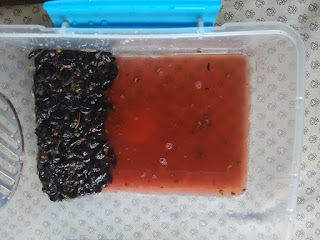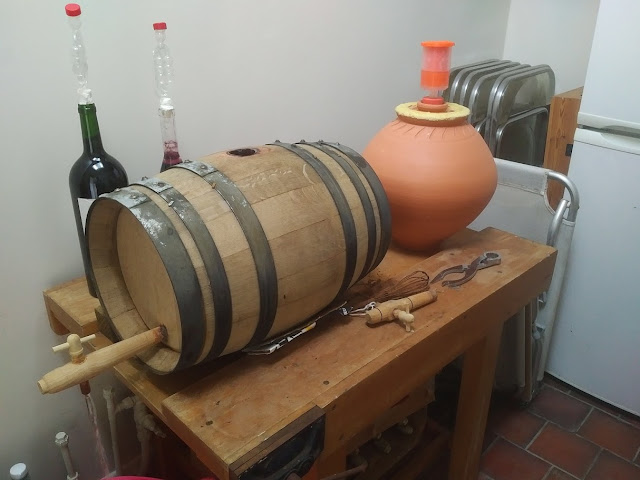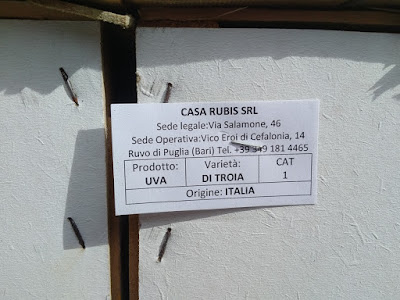 |
| equipment laid out ready for cleaning |
 |
| operating table ready to go |
We attempted 11 different cuvees;
 |
| Macabeo and Malvasia |
 |
| 10 x Bombino boxes ready to go |
White/Orange
Bacchus Orange wine
Bombino Bianco white wine
Field Blend Orange wine
Macabeo Orange wine
Malvasia Orange wine
Solaris and Malvasia Amphora ferment
White 2017 Field Blend macerated on 2018 White Field Blend pomace
 |
| Uva di Troia |
Red Field Blend
White 2017 Field Blend macerated on 2018 Uva di Troia pomace
Uva di Troia
 |
| Chris with his Puglian supplier Giuseppe Tedone. An EU cooperation from 1978 on |
This year we bought from Chris (in order of arrival)
Garnacha (Valencia)
Bombino Bianco (Puglia)
Macabeu (Valencia)
Malvasia (Puglia)
Uva di Troia (Puglia)
 |
| The refrigerated lorry arrives in Hatfield hot from Puglia deliveries are keenly anticipated |
 |
| Grapes are stored under refrigerated conditions |
It had been a great year and quality was very good.
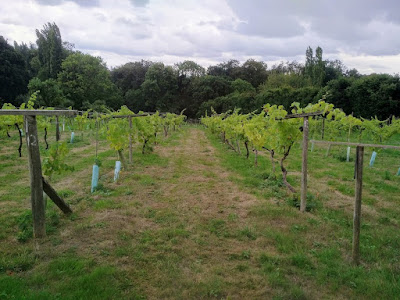 |
| rows of Bacchus after summer pruning |
GM 8107-3
GF 93-22-6
Goldriesling
Helios
Phoenix
Souvignier Gris
Solaris
Dornfelder
Pinot Meunier
Pinot Noir
Pinot Noir Precoce
Rondo
Apart from Bacchus (141 vines), none of these amounted to enough to make a separate vinification - even a microscopic one so we hit on the idea of making Field Blends, combining all the grapes together.
We even pressed a vine growing up a wall into service.
This particular plant has an interesting history. It was given up for dead two years ago but someone told us to stick it in the ground and indeed it came back the next year. We planted it against the wall and it shot up producing 7 nice if small bunches of red grapes. We had thought it was a white variety, Phoenix.
Earlier in the year as we reported we grubbed up our main red variety for 25 years, Triomphe d'Alsace (131 vines) and planted the Blattner variety Cabernet Noir. That explains why we made hardly any red wine from our own grapes this year.
 |
| vines stripped bare by birds |
As it is we made just over 20 litres of Bacchus with what the birds left us.
 |
| white grape pomace |
 |
| red pomace |
 |
| 2018 Field Blend grapes |
 |
| Uva di troia macerating in Speideldum and Speideldee |
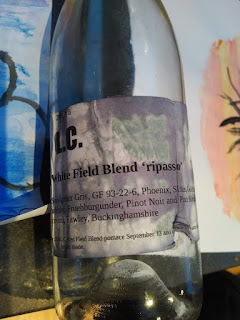 |
| bottle of 2017 white field blend poured over 2018 Uva di Troia pomace after explosion |
 |
| 2018 Red Field Blend fermenting |
 |
| 2017 white field blend after 4 days' maceration on 2018 field blend pomace, returned to original bottles |
 |
| our 2018 white field blend looks great and tastes promising as an orange wine |
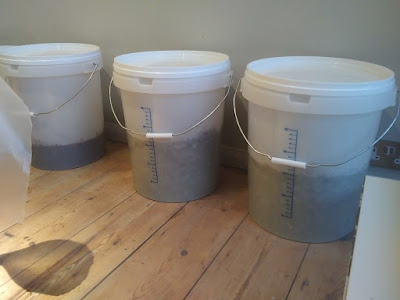 |
| Long maceration - left, white field blend, centre and right Bacchus |
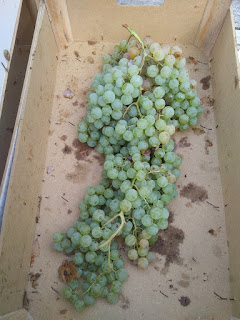 |
| a champion bunch of Maccabeu |
A friend who is a professional potter and ceramicist making handsome art works as well as useful vessels for flowers and other purposes made us an exquisite terracotta amphora with 10 litres capacity. We were very much looking forward to making wine in this amphora in the ancient way or perhaps a la Georgian Qvevri. Reading up on the subject, it seems you can go two ways concerning the preparation of the amphora: to seal or not to seal.
 |
| after coating inside with beeswax |
 |
| patches occur where beeswax coating is insufficient |
 |
| Solaris stalks |
 |
| Solaris berries |
After about 3 weeks we decided to take a look at what was going on. The contents had shrunk to about half and now presented a less than attractive sight, somewhat grey in color smelling of vinegar and smelly feet. We had a bit of Malvasia sitting around so we threw that in up to the brim and re-sealed the amphora. We also injected some Lalvin yeast. After a day or two we fancied seeing the valve bubbling up in a desultory fashion. Not encouraging.
The Geogian recipe for Qvevri wine is to fill the Qvevri at harvest, seal it and re-open it in the spring. That's what we shall do, but with no great expectations.
As well as the amphora we had intended to age 20 litres of wine in our 3 year old French oak barrel. Maintainig barrels is a science of its own - clearly we have much to learn. We had made the cardinal mistake of leaving the barrel empty for many months and then filling it with water on discovering gaps had opened up between some of the staves.
 |
| our patent method of suspending a sulphur candle in the barrel |
 |
| patent method of suspending whisk with sulphur candle |
 |
| boiling water treatment was also in vain |
We have come to the sad conclusion that this is an ex-barrel. As they say, it is time to put flowers in it. We have until March to import a new one under EU freedom of movement of goods rules. Sobering.
 |
| 6 boxes of Garnacha grapes from Castello de Rugat, south of Valencia |
Since the grape comes from Spain originally that is appropriate. We have always liked Garnacha. It is in fact a fabulous variety to work with. We are delighted with the result so far. The beginning of a love affair?
 |
| 16 boxes of Giuseppe's Uva di troia from Ruvo, west of Bari, Puglia |
Uva di Troia had been promised last year but failed to materialise. This year, we had been away when it arrived and somehow our allocation also didn't materialize but a week later we were rewarded with a lovely batch. Determined to fill one of our Speidel 60 litre fermenters and age the wine there, we bought 16 boxes of Uva di Troia grapes (each box weighing 8kg) and found ourselves with more like 70 litres.
Uva di troia is also known as Nero di Troia. It can be a bit soft and flabby but thanks to advice from Giuseppe's papa, we macerated it for a short 48 hours only and it has come up deliciously fresh so far. We think this variety is every bit as good as Primitivo and preferable to Negroamaro and Susumaniello to name the other Puglian red grapes.
After a few weeks in the Speidel and after fermentation, we racked the wine off the gross lees and topped up the fermenter with an excellent organic Uva di Troia called Maree d'Ione for some reason
obligingly on sale at £6.99 a bottle at Waitrose what luck! To our astonishment the level dropped considerably over a short space of time. The angels certainly had been taking their share. We topped the fermenter up again and realised a secondary fermentation was in progress. Could this be the famous Malolactic fermentation? So exciting!
 |
| equipment for sale at Wine Grapes Club, Hatfield |
Chris in Hatfield also sells wine equipment including Demijohns or Damigiani since they come from Italy. Having seen microvinifications ageing in damigiani at the Vivai Cooperativo di Rauscedo we decided to buy some of different sizes, 34 l. and 15 l. mainly. We also bought a 10 l. one online. Even when new these damigiani need a good deal of cleaning before they can be used but we rather like working with them as they are easy to pick up even when full thanks to the handles on their plastic jackets. We haven't dropped one yeat but we have had a couple of close calls.
 |
| bottled: 2018 Red field blend (gold capsules) and Red and White field blends 2017/8 |
At the mention of next year, Chris says 'Don't ask.' He has been importing grapes for nearly 30 years. We don't know of anyone else who does. Of course it would be nice if we could grow all the grapes here but that would mean no Bombino, no Garnacha, no Uva di troia etc. We'll report on the situation next September.
 |
| all gone |






